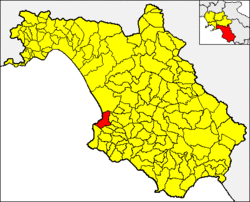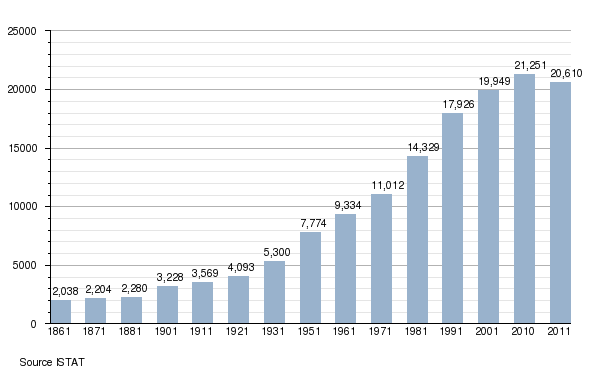Agropoli
| Agropoli | |
|---|---|
| Comune | |
| Comune di Agropoli | |
|
Panoramic view | |
 Agropoli within the Province of Salerno | |
 Agropoli Location of Agropoli in Italy | |
| Coordinates: 40°21′N 14°59′E / 40.350°N 14.983°ECoordinates: 40°21′N 14°59′E / 40.350°N 14.983°E | |
| Country | Italy |
| Region | Campania |
| Province / Metropolitan city | Salerno (SA) |
| Frazioni | Frascinelle, Fuonti, Marotta, Mattine, Moio, Muoio, Madonna del Carmine, San Marco, Tarullo, Trentova |
| Government | |
| • Mayor | Francesco Alfieri (PD) |
| Area | |
| • Total | 39 km2 (15 sq mi) |
| Elevation | 30 m (100 ft) |
| Population (31 December 2011)[1] | |
| • Total | 20,610 |
| • Density | 530/km2 (1,400/sq mi) |
| Demonym(s) | Agropolesi |
| Time zone | CET (UTC+1) |
| • Summer (DST) | CEST (UTC+2) |
| Postal code | 84043 |
| Dialing code | 0974 |
| Patron saint | Sts. Peter and Paul |
| Saint day | June 29 |
| Website | Official website |
Agropoli is a town and comune, former bishopric and present Latin Catholic titular see located in the Cilento area of the province of Salerno, Campania, Italy. It is situated at the start of the Cilentan Coast, on the Tyrrhenian Sea.
As of 2011, its population was of 20,610.[1]
History
Pre-medieval period
The promontory on which Agropoli stands has been inhabited since Neolithic times. It seems, however, that it was not until the later Bronze and Iron Ages that it came to be continuously inhabited by a stable, indigenous population, which lived off hunting and fishing.
To the east of the promontory, at the mouth of the River Testene, there is a natural sheltered bay, called "Foce" in ancient times, but which is now almost completely silted up. Before and after the foundation of nearby Poseidonia (c. 625 BC), the Greeks used it for trading with the local people. They gave the promontory the Greek name, Petra ("rocky hill"), and built a temple on it, dedicated to Artemis, the Goddess of Hunting.
It has been established that in Roman times, on the coastal stretch, now known as San Marco, east of the promontory, and to the right of the Testene, a seaside town called "Ercula" developed and flourished between the 1st century BCE, and the 5th century CE. Meanwhile, the harbour of neighbouring Poseidonia (by then, renamed Paestum by the Romans) became progressively silted up by the process of coastal bradyseism.
Medieval period
During the 5th century, when the Vandals made life difficult in Ercula, its inhabitants retreated to the overlooking promontory, which offered better prospects for defence. Then, in the 6th century, during the Greco-Gothic war (535-553), the Byzantines needed a secure, well-protected harbour, south of Salerno, so they fortified it, and called it Acropolis, meaning 'high town' or citadel. Acropolis remained in the hands of the Byzantines until 882, when the town fell to the Saracens, who turned it into a formidable stronghold (Arabic: rabat). From this base, they set out to plunder and terrorise the surrounding areas, right up to the walls of Salerno. Eventually, in 915, they were driven out from their trenched camp at Garigliano. Acropolis was also liberated, and came back under the jurisdiction of the bishops, who had established their see in (old) Capaccio during this period.
For the rest of the medieval period, the area remained under the protection of the bishops, who also possessed huge territories, including the inhabited areas of Eredita and Ogliastro, as well as the former villages of Lucolo, Mandrolle, Pastina, San Marco in Agropoli and San Pietro in Eredita. This vast area constituted the feudal district of Agropoli which had been ceded to the bishops of Capaccio in Norman times and, except for brief periods, was possessed by them until the early decades of the 15th century. In fact, in 1412, Pope Gregory XII ceded the feudal territories of Agropoli and Castellabate to King Ladislas of Durazzo (1386–1414) in partial payment of some war debts. However, the Crown did not formally take possession until 1443, and before this, on 20 July 1436, King Alfonso V of Naples granted the fiefs of Agropoli and Castellabate to Giovanni Sanseverino, Count of Marsico and Baron of Cilento, requiring him to pay the Bishop of Capaccio 12 ounces of gold annually.
Modern period
The first statistics on Agropoli were compiled in 1445, when the town, including its dependent villages, had a total of 202 homes and, therefore, a similar number of families. Apart from a few changes, such as the temporary transfer to Rodrigo d'Avalos, Marquis of Vasto, from 1505 to 1507, Agropoli and its feudal lands were held by the Sanseverino family until 1552, when Prince Ferrante was accused of treason, and forced to give up all his possessions. After that, Agropoli passed to various families in succession:
- D'Ayerbo of Aragon (1553)
- Grimaldi (after 1564)
- Arcella Caracciolo (1597)
- Mendoza (1607)
- the Filomarino princes of Roccadaspide (1626)
- Mastrillo (1650)
- Zattara
- the Sanfelice, Dukes of Laureana (1660), who possessed the town until the abolition of feudalism in 1806.
Agropoli was a particular target of raids from North Africa in the 16th and 17th centuries, and the population dwindled to only a few hundred inhabitants. On 21 April 1544, the town was sacked, and about 100 people were taken prisoner. On 30 June 1630, a strong band of men from the surrounding Cilento helped the citizens of Agropoli to repel an attack by 700 Turkish pirates. The pirates managed to escape in their ships with a substantial amount of booty and many prisoners, but were nevertheless heavily defeated, and left many dead behind them.
During the 19th century, Agropoli began to expand outside the medieval walls, but the old town has remained intact, together with most of the surrounding defensive walls, and the 7th-century entrance gate.
Ecclesiastical History
Towards the end of the 6th century, the Longobard invasion forced the Bishop of Paestum (Pesto) to take refuge in Acropolis, which then became not only an episcopal see, but the main centre of the surviving Byzantine territories in Tyrrhenian Lucania. In about 592, Pope Gregory the Great wrote to a Bishop Felix at Acropolis, telling him to visit the neighbouring dioceses, which were then without a bishop.[2][3][4][5]
Titular see
No longer a residential bishopric, Acropolis is today listed by the Catholic Church as a titular see,[6] having been nominally restored as Latin Catholic titular bishopric in 1968.
It has had the following incumbents, of the fittest episcopal (lowest) rank or of archiepiscopal (intermediary) rank :
- Titular Bishop Zenon Grocholewski (1982.12.21 – 1991.12.16 see below) as Secretary of Supreme Tribunal of the Apostolic Signatura (1982.12.21 – 1998.10.05)
- Titular Archbishop Zenon Grocholewski (later Cardinal) (see above1991.12.16 – 2001.02.21), as President of Commission for Advocates (1998 – 1999), Prefect of Supreme Tribunal of the Apostolic Signatura (1998.10.05 – 1999.11.15), President of Supreme Court of the Vatican City State (1998.10.05 – 1999.11.15), President of Interdicasterial Commission for Candidates to Sacred Order (1999.11.15 – 2013.01.16), President of Interdicasterial Commission for Equitable Distribution of Priests (1999.11.15 – 2013.01.16), Prefect of the Roman Congregation for Catholic Education (for Educational Institutions) (1999.11.15 – 2015.03.31), President of Pontifical Work for Ecclesiastical Vocations (1999.11.15 – 2015.03.31), Patron of Pontifical Superior Institute of Latinità (1999.11.15 – 2015.03.31), Grand Chancellor of Pontifical Gregorian University (1999.11.15 – 2015.03.31), Grand Chancellor of Pontifical Institute of Sacred Music (1999.11.15 – 2015.03.31), Grand Chancellor of Pontifical Institute of Christian Archaeology (1999.11.15 – 2015.03.31), Grand Chancellor of Pontifical Institute of Arab and Islamic Studies (1999.11.15 – 2015.03.31); later created Cardinal-Deacon of S. Nicola in Carcere (2001.02.21 [2001.05.12] – 2011.02.21), promoted Cardinal-Priest of the same S. Nicola in Carcere as pro hac vice Title (2011.02.21 – ...), Member of College for the review of appeals by clergy accused of delicta graviora (2015.01.21 – ...)
- Titular Bishop Marc Ouellet, Sulpicians (P.S.S.) (2001.03.03 – 2002.11.15) as Secretary of Pontifical Council for Promoting Christian Unity (2001.03.03 – 2002.11.15); later Metropolitan Archbishop of Québec (Canada) (2002.11.15 – 2010.06.30), created Cardinal-Priest of S. Maria in Traspontina (2003.10.21 [2003.10.26] – ...), Prefect of Congregation for Bishops (2010.06.30 – ...), President of Pontifical Commission for Latin America (2010.06.30 – ...)
- Titular Archbishop Pedro López Quintana (2002.12.12 – ...), Apostolic Nuncio (papal ambassador) to Latvia, Apostolic Nuncio to Estonia, Apostolic Nuncio to Lithuania
Geography
The municipality borders with Capaccio, Castellabate, Cicerale, Laureana Cilento, Ogliastro Cilento, Prignano Cilento and Torchiara. The town is few km far from the Ancient Greek city of Paestum.
It includes the hamlets (frazioni) of Frascinelle, Fuonti, Marotta, Mattine, Moio, Muoio, Madonna del Carmine, San Marco, Tarullo and Trentova.
Demographics

Main sights

The town, where some tombs predating the Byzantine period were recently found, also houses the medieval ruins of San Francesco's monastery, and the Churches of the Holy Mary of Constantinople (16th century), San Marco, and San Francesco. The beaches of Trentova Bay contribute to make Agropoli an important seaside resort.
The Angevin-Aragonese castle, which was built on the 6th century Byzantine foundations, still stands on top of the promontory. It has a triangular plan with three circular towers and a moat. To the west of the modern tourist harbour is another small promontory, on which the coastal tower of San Francesco (16th century) stands next to the much altered remains of the convent of the same name.
In the Municipal Antiquarian, there is a sizeable collection of archaeological finds, representing life in the area from prehistoric to medieval times.
Transportation
Agropoli has a railway station on the main line Naples-Reggio Calabria. Road connection is guaranteed by the State Route SS18, which joins with the A3 Motorway at Battipaglia.
Agropoli has also a large tourist port, connected by ferries to Capri, Ischia, Salerno and Naples.
Sports
U.S. Agropoli 1921[7] is the association football club representing the town, and its colors are white and light blue. In the season 2011-12 the team was promoted for the first time from 1990s, from Eccellenza Campania/B to Serie D.
One of the companies of Athletic is the ASD Agropoli Running, founded on October 26, 2011.[8]
Gallery
-

Old town seen from the coast
-
A road in the old town
-
Aragonese Castle
-
.jpg)
Panoramic view
Twin towns
See also
References
- 1 2 (Italian) Source: Istat 2011
- ↑ Francesco Lanzoni, Le diocesi d'Italia dalle origini al principio del secolo VII (an. 604), vol. I, Faenza 1927, pp. 320-323
- ↑ Louis Duchesne, Les évêchés d’Italie et l'invasion Lombarde, in Mélanges d'archéologie et d'histoire, 25 (1905), pp 365-399
- ↑ J. Fraikin, v. Agropoli, in Dictionnaire d'Histoire et de Géographie ecclésiastiques, vol. I, Paris 1909, col. 1046
- ↑ Giuseppe Cappelletti, Le Chiese d'Italia dalla loro origine sino ai nostri giorni, Venezia 1864, vol. XX, pp. 328-329
- ↑ Annuario Pontificio 2013 (Libreria Editrice Vaticana 2013 ISBN 978-88-209-9070-1), p. 828
- ↑ (Italian) US Agropoli website Archived June 22, 2012, at the Wayback Machine.
- ↑ (Italian) Agropoli Running website
Sources and External links
| Wikimedia Commons has media related to Agropoli. |
- (Italian) Agropoli official website
- (Italian) Agropoli on Facebook
- GCatholic with titular incumbent bio links
- Photo Album of Agropoli
- Agropoli on cilento-travel.com